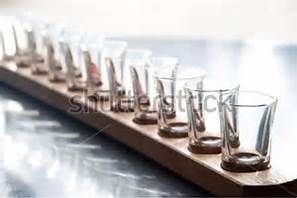-
Posts
1,876 -
Joined
-
Last visited
Content Type
Profiles
Forums
Gallery
Events
Everything posted by Chuck Seiler
-
Wait for the sale.
-
Patrick, I recommend you replace your "Fear of Failure" with "Quest for Achievement". I guarantee you will screw things up, learn from them and move on. You can do like I do, screw things up and pull everything apart...they do it better the next time. I don't think I have built a model yet where I did not have the 'opportunity to improve my skills thru dynamic restructuring'. I have started the SULTANA myself, many years ago, and really like it. It is sitting in my garage getting ready for masting and rigging...one of these days. Go forth and achieve!
- 449 replies
-
- sultana
- model shipways
-
(and 2 more)
Tagged with:
-
To answer your first question...I dunno, I think wooden ship modeling (or ship modeling in general) is in the blood. Once you get bit, you can never really let it go. There always seems to be the lore to get back in and build another one better, or bigger, or more complex. It's in the blood and the only cure is scotch.
-

What is the most EPIC kit available???
Chuck Seiler replied to Rossi46's topic in Wood ship model kits
Rossi, Where do you live? It sounds like you are looking to venture into the dark side; heavy kit bashing at (dare I say) scratch building. If there is a model club near you, I would recommending getting with them as well as interacting here. Sometimes face-to-face discussions and demos can be invaluable. -

What is the most EPIC kit available???
Chuck Seiler replied to Rossi46's topic in Wood ship model kits
I have a mental breakdown just LOOKING at them. -
Keep in mind that the wale(s) were structural members, not decoration or "fenders". In part, they acted like barrel hoops, tying the frames together and also as a strong point for deck clamps, knees, etc. In the 1600s, and prior (not sure of the dates) each frame futtock was secured to a wale rather than it's neighboring futtock. That is why the earlier vessels have so many wales.
-
I own 3 or 4 dremels and I use the snot out of my cordless (with spare battery). Lie any other tool, it has its place. I agree with others that there are times when you DON'T want to use it because it can take too much wood off or offer too little control in making a hole, but I have also found I can now do much more detailed work with it than I could before. It was the ONLY power tool I had for years...until I got a Byrnes saw. I recommend getting the dremel 3 jaw chuck.
-

Drakar by cabrapente - FINISHED
Chuck Seiler replied to cabrapente's topic in - Subjects built Up to and including 1500 AD
Cab, What scale is the model? -

Drakar by cabrapente - FINISHED
Chuck Seiler replied to cabrapente's topic in - Subjects built Up to and including 1500 AD
The Amati DRAKKER only has 9 frames. If he used those plans, he did a bunch of extrapolation. -

Drakar by cabrapente - FINISHED
Chuck Seiler replied to cabrapente's topic in - Subjects built Up to and including 1500 AD
This appears to be a continuation of a previous build log (like it is page 2 or 3) but I see nothing previous. Am I missing something? What are you using for your bolts? -

Mini Mill recommendations
Chuck Seiler replied to StebbinsTim's topic in Modeling tools and Workshop Equipment
Is shaft diameter over 3.2MM (1/8") really problem if all you are using it for is miniature stuff? -
Mick, Why copper for the wale fasteners? Were they bolted in? Having worked with the PHILADELPHIA, I realize they did a lot of non-standard things. Wasn't sure if this was one of them.
- 504 replies
-
- washington
- galley
-
(and 1 more)
Tagged with:
-

Pennants Flown from Mastheads c1770
Chuck Seiler replied to BANYAN's topic in Masting, rigging and sails
As the resident vexillologist, I visit the CRWFLAG/Flags of the World site quite often. -

Pennants Flown from Mastheads c1770
Chuck Seiler replied to BANYAN's topic in Masting, rigging and sails
Commissioning pennants are still in use today. -
What size drill bit did you use? The item you are trying to duplicate is only an inch to 1.5 inches in diameter (scale) Remember, decks are not tree nailed. They are bolted. What you see is a plug used to protect the bolt heads from weather, etc. Plugs, like tree nails, will be subtle. Looking at your model from 3 feet away is like looking at the real ship from 20, 30 feet away. Subtle. If it were me, I would give the deck a good soaking with rubbing alcohol, rip up the deck and re-plank (sez a guy who just ripped off 4 weeks of hull planking to get it right.)
-

Red Paint or Red Ochre
Chuck Seiler replied to davyboy's topic in Painting, finishing and weathering products and techniques
Dave, I agree, in the end, go with the colour you as the builder like. (within reason....I would question the metal flake hot pink and iridescent green...but who am I?) Joel has echoed your thoughts on manufacturer vs difference in color. I think Chuck even mentioned that he used to use one brand, but they changed and the color is slightly different. Anywho, while I will continue to experiment, I have the answers I was looking for. For me, give that a shipyard of yore could mix a batch of paint one day that looks like one panel and then another batch a week later that looks like another panel leads me to a conclusion: Pick the hue I like best for the bulkheads. Pick another for the gun carriages and deck furniture. See if anybody can tel the diff...or if anybody cares. Thanks all.
About us
Modelshipworld - Advancing Ship Modeling through Research
SSL Secured
Your security is important for us so this Website is SSL-Secured
NRG Mailing Address
Nautical Research Guild
237 South Lincoln Street
Westmont IL, 60559-1917
Model Ship World ® and the MSW logo are Registered Trademarks, and belong to the Nautical Research Guild (United States Patent and Trademark Office: No. 6,929,264 & No. 6,929,274, registered Dec. 20, 2022)
Helpful Links
About the NRG
If you enjoy building ship models that are historically accurate as well as beautiful, then The Nautical Research Guild (NRG) is just right for you.
The Guild is a non-profit educational organization whose mission is to “Advance Ship Modeling Through Research”. We provide support to our members in their efforts to raise the quality of their model ships.
The Nautical Research Guild has published our world-renowned quarterly magazine, The Nautical Research Journal, since 1955. The pages of the Journal are full of articles by accomplished ship modelers who show you how they create those exquisite details on their models, and by maritime historians who show you the correct details to build. The Journal is available in both print and digital editions. Go to the NRG web site (www.thenrg.org) to download a complimentary digital copy of the Journal. The NRG also publishes plan sets, books and compilations of back issues of the Journal and the former Ships in Scale and Model Ship Builder magazines.


